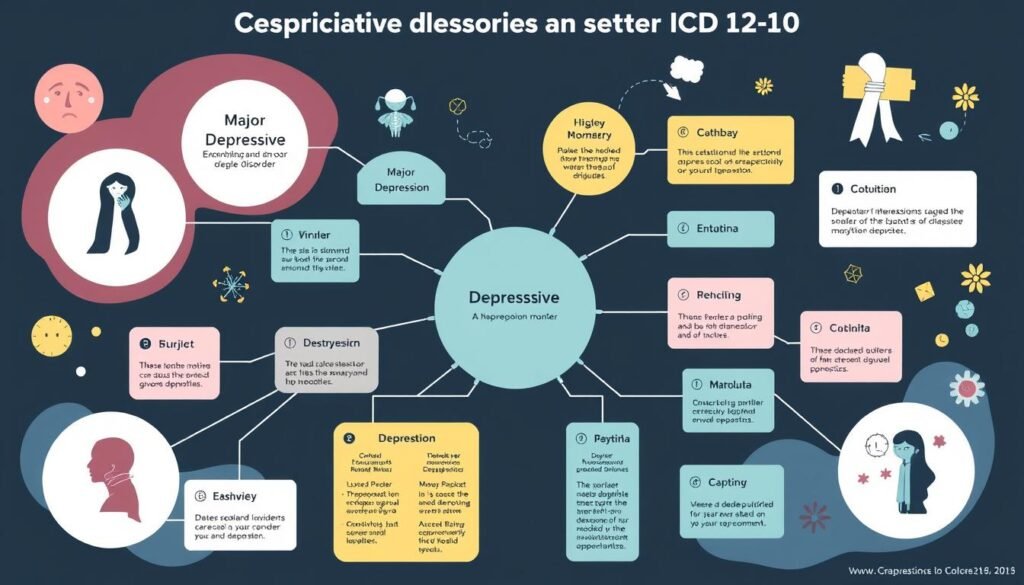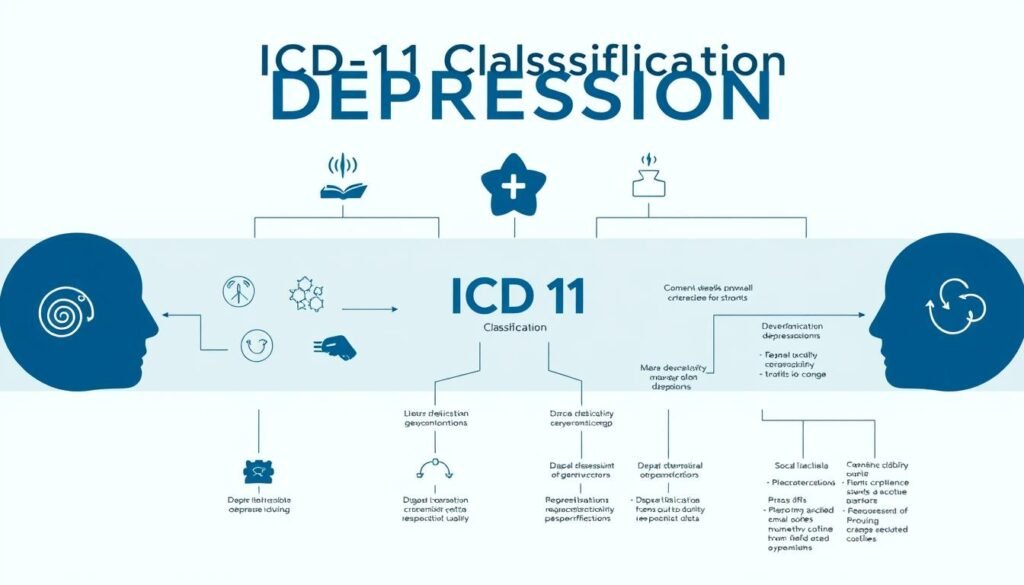About 7.1% of adults in the United States have faced a major depressive episode in the last year. This shows how major depression really affects mental health. It also highlights why having precise, standardized ways to diagnose is so important. The International Classification of Diseases, 10th Revision (ICD-10), is key in the classification of depression. It gives healthcare workers the diagnostic criteria to correctly identify depression.
It’s really important to know and use the ICD-10 guidelines. They help not just in diagnosing but also in making treatment plans for people facing mental health challenges. The ICD-10 is a strong system that ensures doctors can recognize different types of depression. This includes major depressive disorder and persistent depressive disorder. Having such clear criteria is vital for getting better mental health results. It also helps us understand depression more deeply. You can find more about symptoms, reasons, and how to deal with major depression in this detailed article here.
Key Takeaways
- The ICD-10 provides standardized diagnostic criteria for identifying various depressive disorders.
- Approximately 7.1% of adults in the U.S. will experience a major depressive episode.
- Major Depressive Disorder requires at least five specific symptoms for two weeks or more.
- The classification of depression is essential for effective treatment and understanding.
- The procedure for diagnosing depression involves evaluating mood, interest levels, and several key symptoms.
Understanding Depression and Its Impact on Mental Health
Depression is a serious mood disorder. It deeply affects a person’s mental health. People with depression feel sad and lose interest in everyday activities.
This condition makes daily tasks hard and harms well-being. Not just the person, but their family and community, feel its effects. It’s key to truly understand depression.
Defining Depression and Mood Disorders
Mood disorders affect how a person feels emotionally. Depression is a common type, often referred to as Major Depressive Disorder (MDD). It can be mild or severe and changes how someone feels each day.
Its signs include feeling very sad, losing interest in things, and sleeping poorly. Depression does more than alter moods. It affects thinking and physical health too.
Prevalence and Statistics of Depression in the United States
Over 20 million adults in the U.S. face depression each year. It usually starts between 15 to 30 years of age. Women experience it more than men.
Depression also hits those with other illnesses hard. For example, 15-25% of cancer patients suffer from it. Many people with depression struggle with daily life. This makes finding and treating it early very important.
| Statistic | Value |
|---|---|
| Adults with Depression in the U.S. | 20 million+ |
| Onset Age Range | 15 – 30 years |
| Depression Among Cancer Patients | 15-25% |
| Common Gender for Depression | Women |
What is ICD-10 and Its Role in Mental Health Diagnosis?
The International Classification of Diseases (ICD-10) is a detailed system made by WHO. It organizes all types of health issues, including mental health problems. This helps in correctly diagnosing conditions like depression, anxiety, and schizophrenia. It is important for choosing the right treatment and keeping reliable health records.
Overview of the International Classification of Diseases
ICD-10 has thousands of codes that cover every clinical area. Mental health issues are found under the F codes. These codes especially talk about mood problems such as depression and bipolar disorders. With so many people facing mental illness each year, having these codes is key. They help in diagnosing and treating these conditions accurately.
New codes, like those for prolonged grief disorder, show how our understanding of mental health is growing. This progress is important for better support and care.
Difference Between ICD-10 and DSM-5
ICD-10 is used worldwide, while the DSM-5 is used mostly in the United States. The DSM-5’s focus is on specific symptoms and guidelines for diagnosing. This is slightly different from ICD-10’s approach. Both systems recognize depression, but the DSM-5 gives detailed criteria that affect treatment and decision-making. Professionals need to understand these differences for the best patient care.
Depression ICD 10: Diagnostic Criteria
The ICD-10 criteria for depression are crucial for recognizing this mental health issue. It’s important to identify key symptoms that affect daily life and happiness.
Overview of Key Symptoms Identified
The ICD-10 states that depression is diagnosed with certain symptoms over time. Important symptoms to look for include:
- Persistent low mood
- Loss of interest or pleasure
- Fatigue and reduced energy
- Difficulty concentrating
- Feelings of worthlessness
To diagnose depression, a person must show at least five of these symptoms for two weeks or more. When these symptoms are present, they greatly impact a person’s daily functionality.
Duration Requirements for Diagnosis
The ICD-10 sets a minimum duration for these symptoms. They must last for at least two weeks. This duration confirms the condition is not brief sadness. About 35 percent of people face recurring episodes over 15 years.
The table below presents the ICD-10 codes for major depressive disorder:
| Diagnosis Description | ICD-10 Code |
|---|---|
| Major depressive disorder, single episode, moderate | F32.1 |
| Major depressive disorder, recurrent, mild | F33.0 |
| Major depressive disorder, recurrent, moderate | F33.1 |
| Major depressive disorder, recurrent severe without psychotic features | F33.2 |
| Major depressive disorder, recurrent, severe with psychotic symptoms | F33.3 |
Major Depressive Disorder (MDD) Explained
Major Depressive Disorder (MDD) is a big mental health issue. It is marked by constant sadness and losing interest in fun activities. Knowing the MDD criteria well is key for figuring out the problem and helping effectively.
Diagnostic Criteria for Major Depression
The ICD-10 codes help doctors spot major depression. They use codes from F32.0 to F32.9. F32.9 is used for one episode of depression that doesn’t fit other categories. It covers different parts of MDD, like:
- Feeling useless often
- Not wanting to do daily tasks
- Eating much less or more
- Having trouble sleeping
These signs and how they affect a person’s life are key to know if it’s MDD. Knowing the level of severity helps doctors find the best treatment.
Treatment Options for Major Depressive Disorder
There are many ways to tackle depression, suited to what the person needs. Treatments for MDD can include:
- Cognitive Behavioral Therapy (CBT), working on changing negative thoughts
- Drugs that balance brain chemicals
- Support groups for people to share stories and support each other
- Healthy habits like working out and eating right
Changing the treatment based on how the person feels and what they want is vital. A solid treatment plan is very important. It greatly helps in making life better for those dealing with MDD.

Persistent Depressive Disorder and Its Classification
Persistent Depressive Disorder (PDD), known as dysthymia, is in the ICD-10 under code F34.1. It’s defined by a long-lasting low mood, lasting over two years in adults, or one year in kids and teenagers. Knowing about dysthymia helps us tell it apart from other depression types, especially Major Depressive Disorder (MDD).
Understanding Dysthymia within ICD-10
The ICD-10 outlines key aspects of dysthymia. It covers mild depressive symptoms or a significant loss of interest in normal activities. To diagnose, symptoms must be present most of the day, on most days, for the specified time. Kids need to show symptoms for a year, while adults need two years.
How Persistent Depression Differs from MDD
Persistent depressive disorder and major depressive disorder both involve sadness and low mood. However, they differ in key ways. MDD’s symptoms are more intense but may get better. Dysthymia’s symptoms stay and can affect one’s daily life. It can strain relationships and make people feel hopeless.
Those with PDD often face more childhood trauma and interpersonal issues than those with MDD.
| Characteristic | Persistent Depressive Disorder | Major Depressive Disorder |
|---|---|---|
| Duration | At least 2 years in adults, 1 year in children | Symptoms can last for weeks or months, with potential for episodes |
| Severity of Symptoms | Milder, chronic symptoms | More severe, episodic symptoms |
| Functional Impact | Long-term functional impairment | Functional impairment during episodes |
| Childhood Impact | Higher rates of maltreatment and interpersonal issues | Less correlation with childhood experiences |
Understanding the differences between persistent depressive disorder and MDD is crucial for treatment. It helps healthcare workers create personalized treatments for those with long-lasting depression.
Classification of Depressive Disorders under ICD-10
The ICD-10 helps healthcare professionals diagnose depression. It outlines different types of depression and their severity. This way, each patient can get a treatment plan that best suits them.
Types of Depression Diagnosed by ICD-10
The ICD-10 lists many types of depression. Here are some key classifications:
- Major Depressive Disorder (MDD): This can be a single episode (F32.9) or recurrent episodes (F33).
- Persistent Depressive Disorder (Dysthymia): Known by code F34.1, it’s a long-term form of depression.
- Atypical Depression: This type has unique features and is coded F32.89.
- Postpartum Depression: A major concern for new moms, identified with F53.
- Adjustment Disorders: Occurs due to stress, coded as F43.2.
Severity Levels of Depressive Episodes
Determining the severity of depressive episodes helps in treating them. The severity is based on symptoms’ number and intensity. There are different levels:
| Severity Level | Description | ICD-10 Code |
|---|---|---|
| Mild | Few symptoms, manageable but noticeable impact on daily life. | F32.0 (Mild major depressive episode) |
| Moderate | More symptoms present, causing significant difficulties in functioning. | F32.1 (Moderate major depressive episode) |
| Severe | A large number of symptoms; requires immediate intervention and support. | F32.2 (Severe major depressive episode) |
Knowing how to classify depression and its severity helps in deciding on treatment. The PHQ-9 tool can also help evaluate what the patient needs. This improves how we manage depression.

Common Depression Symptoms as per ICD-10
It’s crucial to know the symptoms of depression. The ICD-10 divides them into core and associated symptoms. Understanding these can help catch and treat depression early.
Core Symptoms of Depression
Depression’s main signs are:
- Persistent sadness
- Low energy
- Loss of interest in activities
To diagnose a major depressive episode, these core symptoms must be present. A diagnosis usually needs at least five symptoms for two weeks or more. More severe depression can show as melancholic or atypical subtypes, each affecting treatment differently.
Associated Symptoms that May Present
Besides the main symptoms, others often appear, such as:
- Disturbed sleep patterns
- Feelings of worthlessness or excessive guilt
- Changes in appetite and weight
These symptoms can disrupt someone’s life. For example, sleep problems might be different depending on the person’s age. Knowing all symptoms helps doctors diagnose and treat depression better. For detailed criteria, see the ICD-10 guidelines.
| Core Symptoms | Associated Symptoms |
|---|---|
| Persistent sadness | Disturbed sleep patterns |
| Low energy | Feelings of worthlessness |
| Loss of interest | Changes in appetite |
Challenges in Diagnosing Depression
Diagnosing depression has many challenges, especially with the ICD-10 rules. The complex nature of this mental issue makes it hard to classify and treat properly. Knowing the limitations of ICD-10 is key for doctors who want to help effectively.
Limitations of ICD-10 Criteria
The ICD-10 provides a structured way to diagnose depression, but it has flaws. Sensitivity rates for finding cases range widely, from 1.1% to 35.6%. This shows a big gap in spotting cases accurately. Also, even though the rates of correctly predicting cases are between 89% and 92%, there’s still room for improvement. It’s important for doctors to be careful when diagnosing depression. They should make sure to do a thorough assessment.
Cultural Considerations in Diagnosis
Culture also plays a big part in diagnosing depression. How people show sadness and look for help can depend on their culture. If doctors don’t account for cultural differences, they might miss important signs or misunderstand a patient. Adapting how they diagnose to include various cultural views can make diagnosing more accurate. This ensures treatment fits the patient’s own experience.
Treatment Options for Depression Based on ICD-10
Treatment for depression includes psychological help and medication. It’s designed for each person’s unique needs. Understanding the symptoms and their effects is key. This approach helps manage the condition effectively.
Psychological Interventions
For treating depression, psychological methods like cognitive-behavioral therapy (CBT) are important. They help change negative thoughts and actions that worsen depression. Benefits of these methods are:
- Enhanced coping skills
- Improved emotional regulation
- Increased resilience against future depressive episodes
Tools like the Patient Health Questionnaire (PHQ) help spot depression. The PHQ-9 measures symptoms. It helps doctors decide on the best treatment path for depression.
Medication Management
Managing medication is key in treating depression. Drugs such as SSRIs and SNRIs ease symptoms and help recovery. Doctors review medication and psychotherapy together. They check how well treatments work. Medication management involves these steps:
- Regular side effects monitoring
- Dosage adjustments based on how the patient is doing
- Mixing medicines with psychological methods for better results
The ICD-10 uses codes like F32.9 for major depressive disorder. These codes help doctors understand and explain depression treatments. They make it easier to share details about each case.
Future of Depression Classification: ICD-11 Overview
The change from ICD-10 to ICD-11 is a big deal in mental health. This ICD-11 overview shows updates made over ten years, with input from 15,000 clinicians worldwide. Now, 35 countries have adopted this new system, showing its wide use and relevance.
How ICD-11 Differentiates From ICD-10
ICD-11 brings big changes to how we view depression. It drops the two-week rule for diagnosing major depression. Now, doctors look for five symptoms occurring most days within a specific period. This makes diagnosing more sensitive.
The new system also keeps the “bereavement exclusion.” This means certain criteria must be met for a grief-related depression diagnosis. It’s a step towards understanding mental health’s complex nature.

Moreover, ICD-11 adds new disorders like catatonia and body dysmorphic disorder. This expansion helps mental health professionals recognize a wider range of issues. The goal is to bridge the global mental health treatment gap, focusing on reliability and clinical usefulness, areas where ICD-10 fell short.
The evolution from ICD-10 to ICD-11 underlines the need for an up-to-date classification system. This progress helps clinicians and improves patient care. For more information, you can check this resource. It offers an in-depth look at the ongoing changes and challenges in depression classification.
| Aspect | ICD-10 | ICD-11 |
|---|---|---|
| Duration Requirement | Minimum two-week requirement | Removed, focuses on symptom presence |
| New Diagnostic Categories | Lesser focus on detailed classifications | Includes catatonia, body dysmorphic disorder |
| Bereavement Exclusion | Defined criteria for depression | Retained with scope for nuances |
| Global Adoption | Limited international application | 35 countries currently utilizing |
Conclusion
It’s crucial to correctly diagnose and classify depression following the ICD-10 guidelines. This ensures patients get the right treatments. Reading about the complexity of major depressive disorder helps healthcare workers offer better care. This summary of depression ICD 10 highlights the need for ongoing learning about symptoms and coding.
Using ICD-10 standards well helps in giving proper treatment. It also improves how healthcare teams communicate. Being accurate in documenting and classifying depression is key for monitoring treatment. This process is vital to enhance patients’ lives and recovery success.
Raising awareness about depression is critical for everyone involved in healthcare. Dealing with mental health issues requires teamwork and continuous study. This is the way to build better support and understanding for those affected.